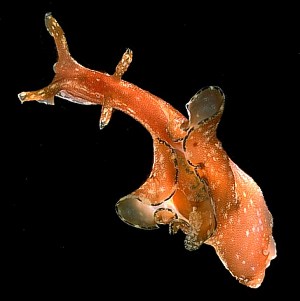
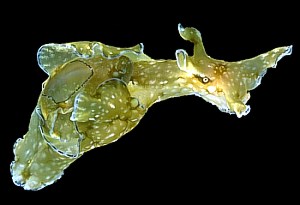
Aplysia parvula
Guilding in Morch, 1863.
Order: ANASPIDEA
Superfamily: APLYSIOIDEA
Family: Aplysiidae
DISTRIBUTION
World-wide distribution in tropical to warm temperate waters.
PHOTO
Two colour forms from Parsley Bay, Vaucluse, Sydney Harbour, NSW, Australia. September 1982.
Showing the typical oral tentacles at the front of the head, on either side of the mouth and the smaller rhinophores just above the eyes. At the back you can see the large parapodial flaps which have a black edge. These parapodia enclose the mantle cavity in which the fragile plate-like shell is found. In the lower photo, part of a black ring can be seen. This outlines the hole (foramen) which leads to the cavity in which the shell is found. PHOTO: Bill Rudman.
Probably the smallest species of Aplysia, reaching a maximium length of about 6cm. Usually a mottled brown or green body, but sometimes a more uniform colour, it usually has a dark border to the parapodia, and the large mantle foramen. The tips of tentacles are usually darker than the background colour. There is a similarly sized and shaped species which is black with pale borders. See pictures on Aplysia cf. parvula page.
See discussion about whether black-lined animals from Europe are Aplysia punctata or Aplysia parvula.
See the General Topics List for more information on Sea Hares.
Reference:
• Morch, O.A.L. (1863). Contributions a la faune malacologique des Antilles danoises. Journal de Conchyliologie 11: 21-43.
Rudman, W.B., 1999 (April 25) Aplysia parvula Guilding in Morch, 1863.. [In] Sea Slug Forum. Australian Museum, Sydney. Available from http://www.seaslugforum.net/find/aplyparv
Related messages
Aplysia parvula from sthn Queensland
August 20, 2009
From: Gary Cobb
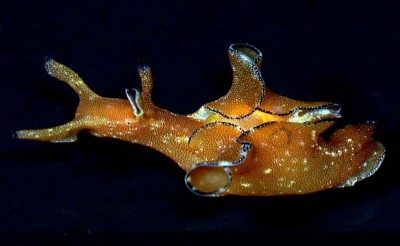
Concerning message #20992:
Hi Bill and everyone!
Here is a record of Aplysia parvula from our area. It comes in what appears to be 3 colour forms. Red, Orange and yellow. Found at it's food source which is the colour it resembles.
Locality: Mooloolaba, Sunshine Coast, 10 mm - 12 m, Queensland, Australia, Pacific Ocean, 15 June 2009, Subtidal and Intertidal. Length: 1 mm - 38 mm. Photographer: Gary Cobb and David Mullins.
Cheers
Gary and David
gary@nudibranch.com.au
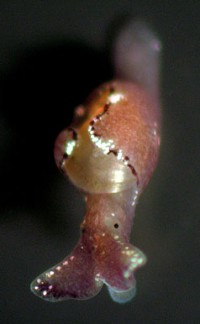


Thanks Gary,
I also like the photo of the juvenile animal. In juveniles, the shell is completely external, like in a snail. As they grow, the mantle tissue from inside the shell extends out from under the shell and folds over gradually covering much of the upper surface.
Best wishes,
Bill Rudman
Nudibranch? from Bay of Islands, New Zealand
April 3, 2008
From: Junya Kato
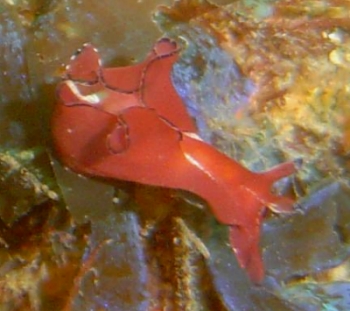
I have taken this photo on the Rainbow Warrior which has been resting in Cavalli Islands, New Zealand for last 22 years. I have never seen this particular one before since I started diving in 2003. I am wondering if anyone know the name and details of this particular species.
Locality: Cavalli Islands, 20 metres, northeastern New Zealand, Southwest Pacific, 18 October 2007, Shipwreck . Length: 5 - 8 mm. Photographer: Junya Kato.
Thank you,
Junya Kato
scubaninja.j@gmail.com
Kato, J, 2008 (Apr 3) Nudibranch? from Bay of Islands, New Zealand. [Message in] Sea Slug Forum. Australian Museum, Sydney. Available from http://www.seaslugforum.net/find/20992Dear Junya,
I must say it still makes me angry when I think of the Rainbow Warrior. It was certainly not the most glorious episode in the history of France.
Your slug is the small Sea Hare, Aplysia parvula. Have a look at the messages attached to that page to find out more about the species and go to the Sea Hare Fact Sheet for links to more general information.
Best wishes,
Bill Rudman
Aplysia parvula from the Madeira Islands
February 4, 2008
From: Magno Freitas
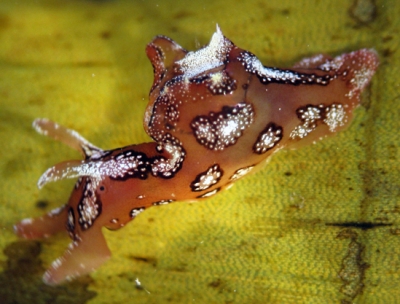
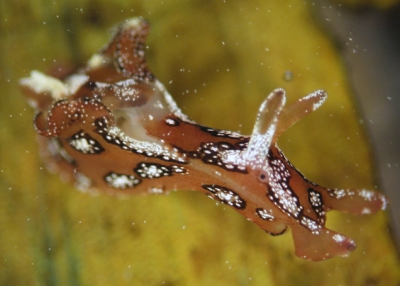
Concerning message #10382:
Dear Bill
I find a very small Aplysia in Madeira Island last Summer. Analysing some digital photos of the animal it seems to be the same colour form of your specimen from Senegal. It seems to be Aplysia parvula...
Locality: Reis Magos, Madeira Island, 5 metres, Atlantic, 10 August, 2007, Under small stones. Length: 15 mm. Photographer: Magno Freitas.
Magno Nicolau B. Freitas
mgnbfreitas@yahoo.com
Freitas, M.N.B., 2008 (Feb 4) Aplysia parvula from the Madeira Islands. [Message in] Sea Slug Forum. Australian Museum, Sydney. Available from http://www.seaslugforum.net/find/21322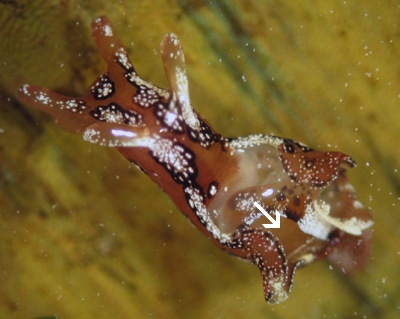
Dear Magno,
Thanks for this interesting record. It certainly seems the same colour pattern as the Senegalese animals and in the photo alongside we can clearly see the extremely large foramen [= opening in the mantle] exposing much of the brownish shell. A large foramen like this is a characteristic feature of A. parvula.
Best wishes,
Bill Rudman
Aplysia parvula in Reunion Island
February 1, 2007
From: Philibert Bidgrain
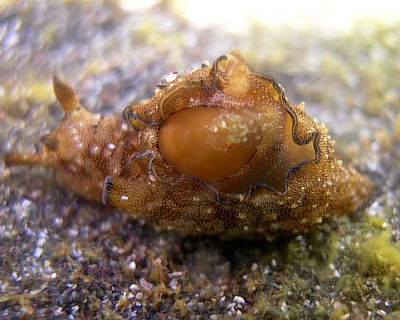
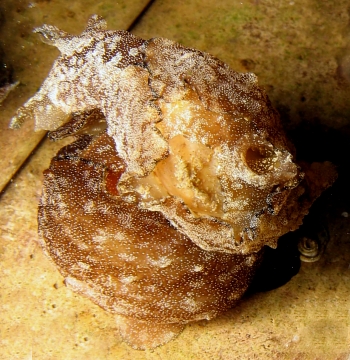
Dear Bill,
We have found some specimens (size: less than 30 mm) of a species which I think are specimens of Aplysia parvula. In the smallest specimen, the border of the parapodia is blue while in the two larger specimens the border of the parapodia is less visible by seems to be black...
Are they able to produce a purple ink?
You say "Aplysia juliana is one of the few species of Aplysia that lacks the ink gland which produces the characteristic reddish purple ink". Is it also true for A parvula?
What's the main difference with A. juliana?
Locality: Saint Gilles, 10 cm, Reunion Island, Indian Ocean, December 2006, lagoon. Photographer: Philibert Bidgrain.
Philibert Bidgrain
http://vieoceane.free.fr/runseaslug/indexslug.htm
pbidgrain@yahoo.fr
Bidgrain, P., 2007 (Feb 1) Aplysia parvula in Reunion Island. [Message in] Sea Slug Forum. Australian Museum, Sydney. Available from http://www.seaslugforum.net/find/19302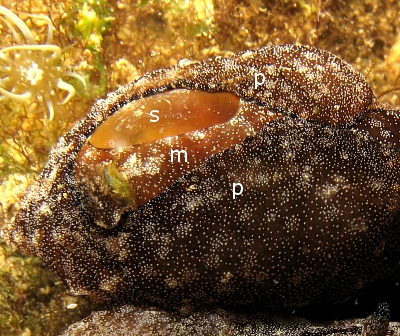
Dear Philibert,
Aplysia parvula is a relatively small species which usually has a blackish border to the parapodia. There is another species? or colour form which is black with a whitish border [see Aplysia cf. parvula ]. I am reluctant to give a strict definition of this species because there is so much variability in its colour pattern - or else there are a number if very similar species with slight colour differences. That is why I have many photos of Aplysia parvula and Aplysia cf. parvula on the Forum so you can get a full picture of what we consider at present to be one species. Certainly the colour form in your photos, with tiny white specks, is not an uncommon colour form of the species.
I have included a close-up alongside which shows a very distinctive feature of the species, and that is the very large hole or foramen [= window in Latin] in the mantle, through which we can see, and touch, the brownish shell. [In the photo p = parapodia; m = mantle; s = shell].
A. parvula does indeed produce purple ink, but as I have mentioned elsewhere, it needs to feed on red algae to produce it, and it does not have an endless supply of the ink. If it has recently 'inked' then it needs to feed again to build up another supply of the ink. Apart from the large foramen, black edge to parapodia, size, and inking, it differs from A. juliana in the way it walks along. Aplysia juliana has a peculiar form of crawling, which I described earlier [message #19303], while A. parvula crawls along smoothly like most slugs.
Best wishes,
Bill Rudman
Sea Hare from Indonesia
November 23, 2006
From: Linda Ianniello
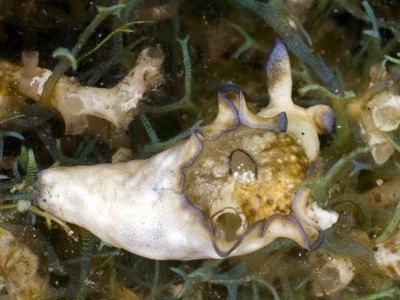
Concerning message #18378:
I believe this is a sea hare, but I can't find anything like it in any of my ID books. It was very small, as you can see from its surroundings.
Locality: Sambousa Island, Sangean, Tikno Reef, 60 feet, Indonesia, 5 September 2006, Coral reef. Photographer: Linda Ianniello.
Regards,
Linda I.
lindai1@bellsouth.net
Ianniello, L.M., 2006 (Nov 23) Sea Hare from Indonesia. [Message in] Sea Slug Forum. Australian Museum, Sydney. Available from http://www.seaslugforum.net/find/18495
Dear Linda,
This is a juvenile Aplysia parvula. The dark border to the small parapodial flaps, and the dark-tipped tentacles are characteristic of that species. Another good indication is the large black-edged hole [foramen ] in the middle of the mantle, through which you can see the shiny shell. In most species of sea hare the foramen is very small, often reduced to a pore on the tip of a slightly raised papilla.
Best wishes,
Bill Rudman
Hawaiian Aplysia?
July 20, 2006
From: Sean Kearney

Hello Bill
...As often happens, while looking at photos I find critters that didn't see while taking the photo. The poor quality of these pictures requires that I send two photos to see the whole animal. Aplysia sp?.
Locality: Makaha Caverns, 25 ft., Oahu, Hawaii, Pacific, 12 July 2006, Coral reef. Length: 3/8 inch. Photographer: S. Kearney.
Would appreciate ID help.
Thanks for your great site.
Sean Kearney
skearney@dc.rr.com
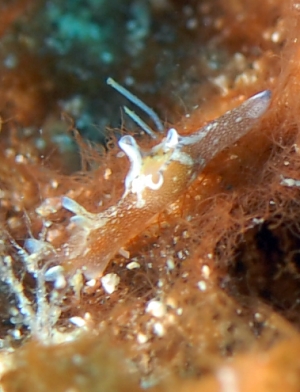
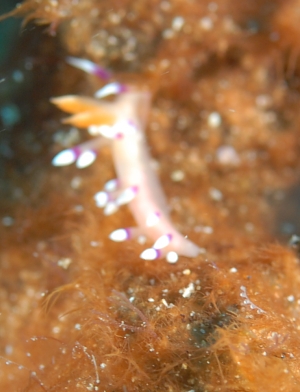
Dear Sean,
The animal ringed in your upper photo [also lower left photo] is a juvenile Aplysia parvula. The animal in your second photo, of which I have only included a close-up [lower right] is almost certainly Flabellina exoptata
Best wishes,
Bill Rudman
Aplysia parvula from sthn Queensland
February 10, 2006
From: Bruce Wilkie
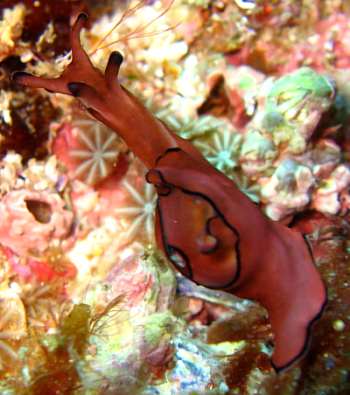
Hi Bill,
Found this one which I think is Aplysia parvula?
Thought you might like it for your records.
Locality: Flat Rock North Stradbroke Island, Queensland, Australia. Depth: 14 metres. Length: 70 mm. 15 January 2006. rocky reef with sponges, hard & soft corals. Photographer: Bruce Wilkie
Many Thanks,
Bruce Wilkie.
brucedwilkie@yahoo.com.au
Wilkie, B., 2006 (Feb 10) Aplysia parvula from sthn Queensland. [Message in] Sea Slug Forum. Australian Museum, Sydney. Available from http://www.seaslugforum.net/find/15737Dear Bruce,
Yes this is a colour form of A. parvula. This pinkish form is usually found in areas where there is a lot of red algae but we need someone to do some work to see if the colour of the algae the sea hares are feeding on affects the colour of their skin.
Best wishes,
Bill Rudman
Please identify this Sea Hare
February 2, 2006
From: Eileen Baker
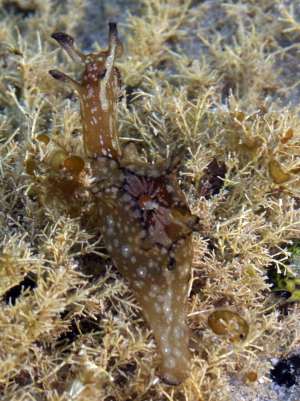
Dear Bill
We believe these sea hares are Aplysia parvula, could you please confirm this identification. There were about 5 in a pool about 4m squared. We are also very impressed with your website - it was a joy to find it!
Locality: Ann Bay/Green Point, NW Tasmania, Australia. Southern Ocean. Depth: 30 cm. Tasmania, Length: 80-100 mm. 30 December 2005. Intertidal sandy pool. Photographer: Eileen Baker
Thanks,
Eileen
bakersla@bigpond.net.au
Eileen, E.S., 2006 (Feb 2) Please identify this Sea Hare. [Message in] Sea Slug Forum. Australian Museum, Sydney. Available from http://www.seaslugforum.net/find/15720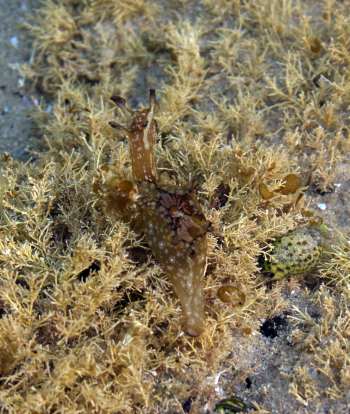
Dear Eileen,
Yes these are Aplysia parvula. They usually have a darker brown line around the edge of the parapodia, and a large foramen [see Sea Hare mantle] which is also lined with dark brown.
As your photo shows, this little sea hare is often difficult to see in mixed coralline algal turf.
Best wishes,
Bill Rudman
Re: Aplysia parvula - color forms?
January 24, 2006
From: Asther M. Lau
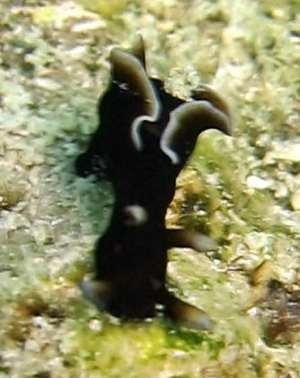
Concerning message #7432:
Dear Bill,
Referring to my last message [#15585], here is another image of similar nudibranch, but found at a different site and different day. A color form sample as mentioned by Scott.
Locality: Dong King Yama, Kapalai Is. Sabah, Malaysia. Celebes Sea. Depth: Approx. 8 meters. Length: Approx. 1.5 cm. 17 March 2004. Sandy with rock gravels. Photographer: Asther M. Lau
I'm just amazed at its tiny size. Very hard to spot.
Thank you!
Asther
asther@astherlau.com
Lau, A, 2006 (Jan 24) Re: Aplysia parvula - color forms?. [Message in] Sea Slug Forum. Australian Museum, Sydney. Available from http://www.seaslugforum.net/find/15588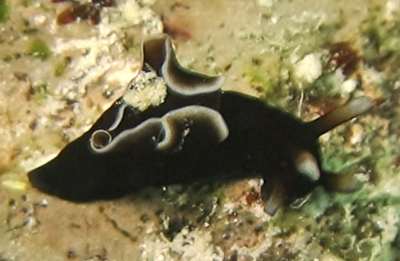
Thanks Asther,
Bill Rudman
Re: More on Aplysia parvula color forms
January 24, 2006
From: Asther M. Lau
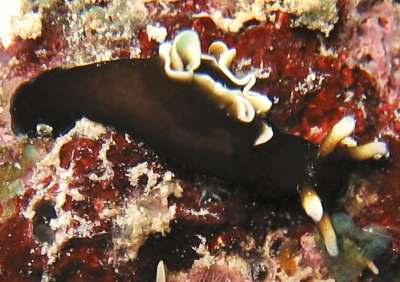
Concerning message #7483:
Dear Bill,
Here's a sample of Aplysia parvula (color variation)
Locality: Maki Point, Kapalai Is. Sabah, Malaysia.Celebes Sea. Depth: approx. 12 meters. Length: Approx. 2 cm. 14 March 2004. Tide was going down. Sandy with rock gravels. Photographer: Asther M. Lau
Asther M. Lau
asther@astherlau.com
Lau, A, 2006 (Jan 24) Re: More on Aplysia parvula color forms. [Message in] Sea Slug Forum. Australian Museum, Sydney. Available from http://www.seaslugforum.net/find/15585Thanks Asther,
Bill Rudman
Aplysia parvula from eastern Russia
January 12, 2006
From: Alexei Chernyshev
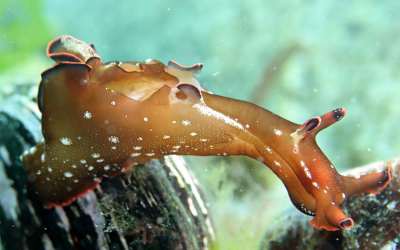
Dear Bill,
In September two adult specimens of Aplysia parvula were collected in Peter the Great Bay (Japan Sea). It is unusual finding for cold Russian waters.
Locality: Furugelm Island, Peter the Great Bay (Japan Sea), Russia. Depth: 2-3 metres. Length: 65-70 mm. September 2005. On stones and mussels. Photographer: Ratnikov A.V.
Sincerely yours,
Alexei
[for Chernyshev, A.V., Ratnikov, A.V., & Chaban, E.M]
tsher@bio.dvgu.ru
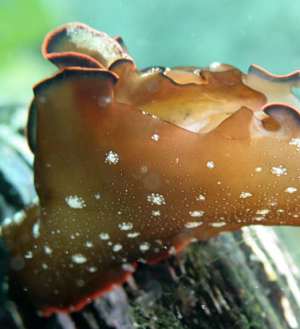

Dear Alexei,
Thanks for this interesting record. The reddish border is rather unusual.
Best wishes,
Bill Rudman
Aplysia parvula from Halmahera, Indonesia
June 9, 2005
From: Richard Harlan

Dear Sirs,
I just got back from exploratory diving in Halmahera, Malocco, Indonesia.
And I saw this nudibranch in the depth around 15 metres, with the length of around 1 cm. I have never seen this before, so I check in this website, and I guess this is Aplysia parvula, isn't it?
Locality: Latalata Island, Goraichi, Halmahera, Patingti Straits, Indonesia. Depth: 15 metres. Length: 1 - 1.5 cm. 21 May 2005. Ordinary corals. Photographer: Richard Harlan
Regards,
Richard Harlan
richardkurni@gmail.com
Harlan, R., 2005 (Jun 9) Aplysia parvula from Halmahera, Indonesia. [Message in] Sea Slug Forum. Australian Museum, Sydney. Available from http://www.seaslugforum.net/find/13930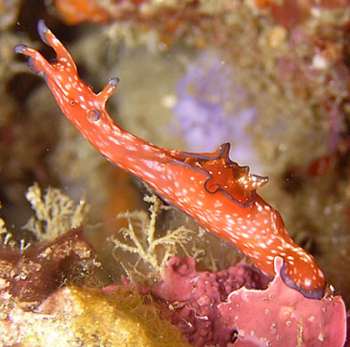
Dear Richard,
Yes this is Aplysia parvula. The lower photo shows the classic searching behavioue many opisthobranchs exhibit when they are 'sniffing' around trying to orient themselves. Being essentially blind, stretching out and waving their head and sense organs around, helps them to find something to crawl on to, and to find possible food scents in the water [see Sea Hare head Fact Sheet].
Best wishes,
Bill Rudman
Aplysia parvula laying eggs
May 26, 2005
From: Dong Bum Koh
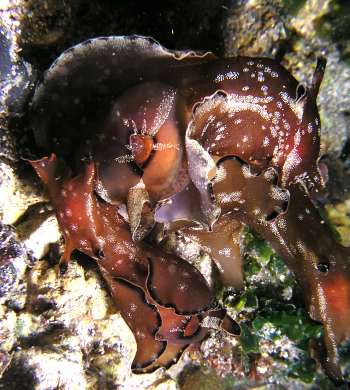
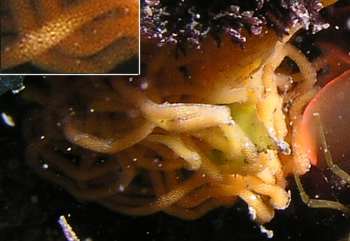
Dear Bill,
Here are some photos of what I think is Aplysia parvula with its mating and eggs for the Sea Slug Forum.
Locality: Hwa Soon, Jeju Id, Sth Korea. Depth: 4 m. Length: 20 mm. 18 May 2004. Rocky bottom. Photographer: Sang Yual Shin
Best regards,
Dong Bum Koh
drkoh@seasee.co.kr
D. B. Koh, 2005 (May 26) Aplysia parvula laying eggs. [Message in] Sea Slug Forum. Australian Museum, Sydney. Available from http://www.seaslugforum.net/find/13800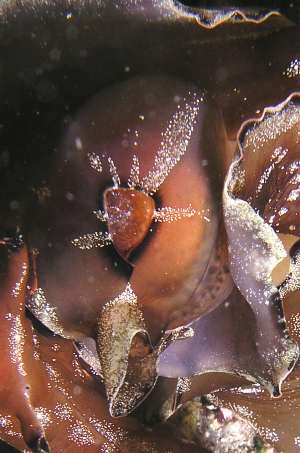
Dear Koh,
Thanks for these photos which I agree are of Aplysia parvula. I have included a close-up here of part of the upper photo, as it shows the inside of the parapodial cavity of a Sea Hare very well. The black ring, with whitish rays radiating out from it, is the edge of a hole [foramen] in the mantle, which exposes part of the shell, which lies embedded in the mantle tissue. We can see part of the brown shell quite clearly. Aplysia parvula is one of a few species with a large hole like this. In most species there is only a tiny pore, sometimes on a small papilla. Directly below the foramen, in the photo, we can see a tube or funnel, which is the exhalent siphon which directs water out of the mantle cavity. The mantle cavity is directly below the shell, so we can't actually see it. In it sits the gill and the reproductive openings.
Best wishes,
Bill Rudman
Re: Aplysia parvula - eaten by Nemertine worm
May 3, 2005
From: Jon Norenburg
Re message #13659:
Excellent! This brought a smile of sheer delight! This snake-like feeding is exactly how I always characterize the feeding by most hetero- and palaeonemerteans. The proboscis is used to catch and hold relatively nimble prey (such as worms and crustacea) but may not have been used in this case. These nemerteans frequently simply engulf prey items such as snails and bivalves. Also like snakes, they appear to be able to sustain themselves for long periods of time on a large meal, which may be why their feeding is observed relatively rarely.
Thanks so much for sharing this.
Jon Norenburg
Curator of Nemerteans, NMNH
Washington, DC
norenbur@lab.si.edu
Norenburg, J.N., 2005 (May 3) Re: Aplysia parvula - eaten by Nemertine worm. [Message in] Sea Slug Forum. Australian Museum, Sydney. Available from http://www.seaslugforum.net/find/13699Aplysia parvula - eaten by Nemertine worm [1]
April 29, 2005
From: Dong Bum Koh
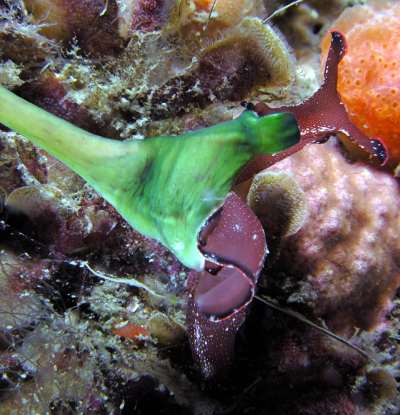
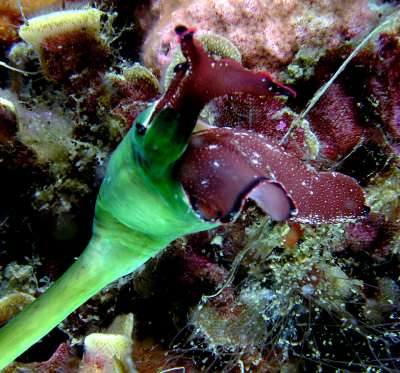
Dear Bill,
Here are a set of photos for your Forum showing Aplysia parvula meeting a terrible end. It was eaten by Lineus fuscoviridis. [Phylum Nemertea]. It looks like a snake eating its prey. [see message #13660 for further photos]
The whole sequence captured in these photos took just over 2 minutes: 14:45:27 - 14:47:37
Locality: Gam Po Beach, Kyung Book Province. South Korea. Depth: 11 m. 17 April 2005. Rocky bottom. Photographer: Ok Soo Kim
Best regards,
Dong Bum Koh
drkoh@seasee.co.kr
D. B. Koh, 2005 (Apr 29) Aplysia parvula - eaten by Nemertine worm [1]. [Message in] Sea Slug Forum. Australian Museum, Sydney. Available from http://www.seaslugforum.net/find/13659Dear Koh,
Thank you, and Ok Soo Kim, for sharing these fascinating and spectacular photos with us. I have put the final photos in the sequence in a separate message [#13660 ].
We don't get many observations of what eats sea slugs so this is a valuable addition to our knowledge of the biology of Aplysia parvula. Elsewhere on the Forum pycnogonids [sea spiders] are reported to be a major predator in Australia.
For those of you unfamiliar with nemertine worms, their mouth opens below the head, and they have a characteristic eversible proboscis which is separate from the mouth and is used in capturing the prey. I can't see any sign of the proboscis in these photos which shows the sea hare being quickly engulfed by the highly extensible mouth. The squarish green bit lying along the 'neck' of the sea hare is the worm's head.
Best wishes,
Bill Rudman
Aplysia parvula - eaten by Nemertine worm [2]
April 29, 2005
From: Dong Bum Koh
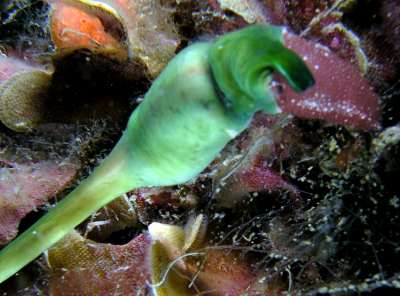
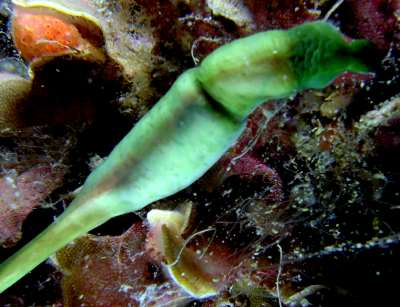
Dear Bill,
Here are a some more photos showing Aplysia parvula being eaten by Lineus fuscoviridis. [Phylum Nemertea]. It looks like a snake eating its prey. [see message #13659 for the first photos in this sequence]
The whole sequence captured in these photos took just over 2 minutes: 14:45:27 - 14:47:37
Locality: Gam Po Beach, Kyung Book Province. South Korea. Depth: 11 m. 17 April 2005. Rocky bottom. Photographer: Ok Soo Kim
Best regards,
Dong Bum Koh
drkoh@seasee.co.kr
Koh, D. B. , 2005 (Apr 29) Aplysia parvula - eaten by Nemertine worm [2]. [Message in] Sea Slug Forum. Australian Museum, Sydney. Available from http://www.seaslugforum.net/find/13660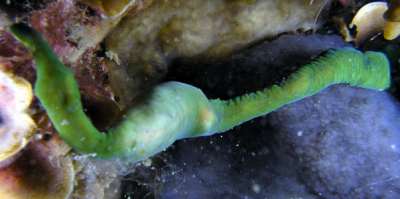
Dear Koh,
As you say, the whole sequence is uncannily reminiscent of a snake, both in the engulfing of the prey, and in later photos, the large swollen section of the body indicating the undigested prey. It reminds me very much of a large python I saw, while living in Tanzania, some minutes after it had swallowed a neighbour's dog
Best wishes,
Bill Rudman
Aplysia parvula from Fethiye Bay, Turkey
July 15, 2004
From: Ant Turkmen
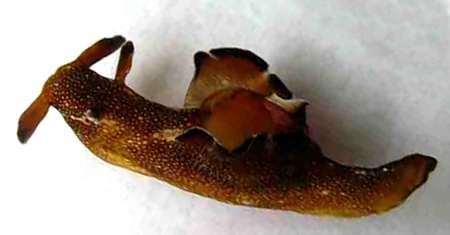
Dear Bill,
Here is a photo of Aplysia depilans from Fethiye Bay, Turkey
Date: 27 March 2004
Depth: 2 m
Ant Turkmen
antturkmen@superonline.com
Turkmen, A., 2004 (Jul 15) Aplysia parvula from Fethiye Bay, Turkey. [Message in] Sea Slug Forum. Australian Museum, Sydney. Available from http://www.seaslugforum.net/find/12599Dear Ant,
This is an interesting find. It is Aplysia parvula rather than A. depilans. The very exposed shell and blackish border to the parapodia are good chracters of this species. We have a couple of records on the from of this species from the Mediterranean [m1435, m7499] and I have discussed the differences been this species and the related A. punctata in a separate message [m9803].
Whether A. parvula has a natural distribution in the Atlantic and Mediterranean or has been introduced by man's activities is a question which may be difficult to answer.
Best wishes
Bill Rudman
Aplysia parvula from South Australia
January 15, 2004
From: Carol van der Pennen
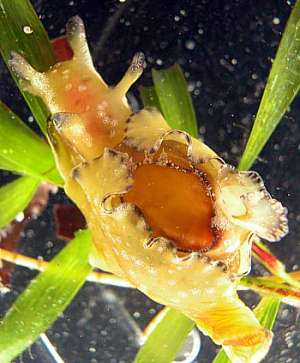
Dear Bill,
The photographs attached are of an animal I think is Aplysia parvula, found at Haycock Point, South Australia while snorkelling. Two animals were grazing on a cluster of zoanthids, and I was able to gently remove one for some photographs, returned unharmed to the same location. I would appreciate a confirmed ID of the animal, and hope the photos are of use to you. The foramen is clearly visible in all 3.
Thanks for your help,
Carol van der Pennen
vdp@netspace.net.au

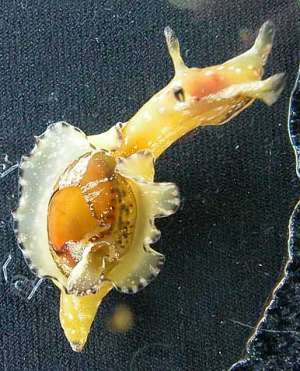
Dear Carol,
Yes this is Aplysia parvula. As you say, these photos clearly show the brown shell through the wide open mantle foramen.
Best wishes
Bill Rudman
Colour variation in Aplysia parvula
December 16, 2003
From: Marina Poddubetskaia
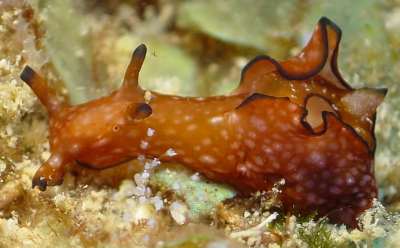
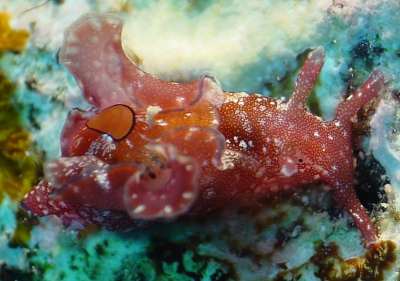
Dear Bill,
I know you have many Aplysia parvula photos on the Forum, but I'd like to add these ones because they show the variability in Indian specimens.
The parapodia edge ranges in colour from black to pale blue. The foramen is widely open (the internal shell can be seen in all the photos) and it can be bordered with black or not. The body colour varies too. Especially, the second specimen is very similar to the Mediterranean A. parvula.
This species is quite common in Mayotte. All the specimens were moved for the photo. But most of them were found inside a red alga which I have sent in a separate message. In the Mediterranean, A. parvula is often found in the very similar alga Sphaerococcus coronopifolius.
Upper 2 Photos: November 11, 2003. Bandrele, Mayotte Island, Indian Ocean., Site: Passe Bandrele,
Depth: 8-9m., Size: Upper: 12mm., Middle photo: 15mm.
Lower Photo: November 13, 2003. Location: Mayotte Island, Indian Ocean., Site: Passe en S, buoy n° 1bis., Depth: 20m
Size: 10mm
Cheers,
Marina.
nembro@nembro.info
Poddubetskaia, M., 2003 (Dec 16) Colour variation in Aplysia parvula. [Message in] Sea Slug Forum. Australian Museum, Sydney. Available from http://www.seaslugforum.net/find/11648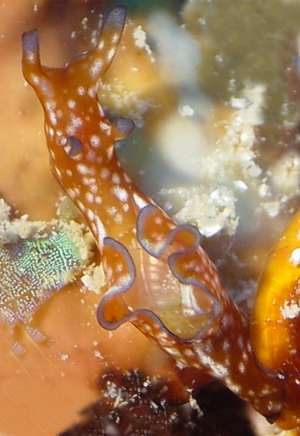
Thanks Marina,
I always welcome photos showing variation like this. The photos of this species on the Forum have helped to clarify the identity of this species worldwide.
Best wishes
Bill Rudman
Food of Aplysia parvula in Mayotte
December 16, 2003
From: Marina Poddubetskaia
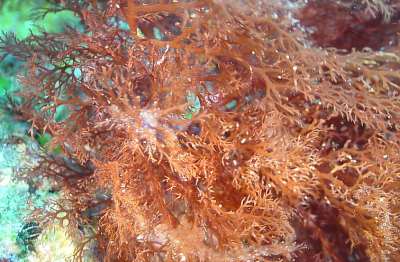

Dear Bill,
Here are photos of the algae my Aplysia parvula from Mayotte, were feeding on. Most of them were found inside this red alga. Do you know what species is it? In the Mediterranean, A. parvula is often found in the very similar alga Sphaerococcus coronopifolius.
Marina
nembro@nembro.info
Poddubetskaia, M., 2003 (Dec 16) Food of Aplysia parvula in Mayotte. [Message in] Sea Slug Forum. Australian Museum, Sydney. Available from http://www.seaslugforum.net/find/11649Thanks Marina,
There has been a lot of interesting research on feeding in this species and it seems that some species of red algae are preferred over others, and the preferred ones contain metabolites [chemical compounds made by the plant] which are stored by the sea hares for their own defense. [see earlier message]. In SE Australia Delisia pulchra and Laurencia obtusa are the preferred algae, but I am not an expert on Indian Ocean algae.
Best wishes
Bill Rudman
Re: Other Aplysia parvula from Senegal
July 17, 2003
From: Marina Poddubetskaia
Dear Bill,
Concerning your question, I'm sorry but I haven't any photos which actually show the foramen in this Aplysia from Senegal.
Cordially,
Marina.
nembro@nembro.info
Poddubetskaia, M. , 2003 (Jul 17) Re: Other Aplysia parvula from Senegal. [Message in] Sea Slug Forum. Australian Museum, Sydney. Available from http://www.seaslugforum.net/find/10461Thanks Marina,
Sorry I seem to ask for impossible photos, but your wonderful photos excite my interest
Best wishes,
Bill Rudman
Re: Aplysia parvula from Outer Hebrides
July 11, 2003
From: Jun Imamoto
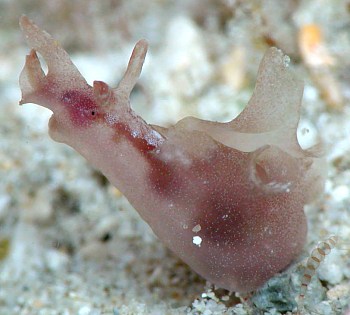
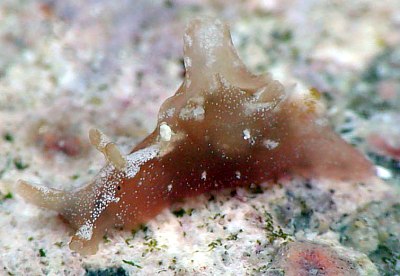
Dear Bill,
I was classifying this animal with Aplysia parvula but from your recent comments on the animal from the Outer Hebrides, it seems to be wrong. I would be very happy if I could hear your comment.
Date: 14 Mar 2003
Location: Kurasaki beach, Amami Ooshima Islands, Japan.
Size approx: 8mm (upper image)
Size approx: 6mm (lower image)
Depth: 3m
Temperature: 20C
Photos: Jun Imamoto
Best Regards,
Jun Imamoto
http://umiushi.zive.net/
imamoto@wips.co.jp
Imamoto, J., 2003 (Jul 11) Re: Aplysia parvula from Outer Hebrides. [Message in] Sea Slug Forum. Australian Museum, Sydney. Available from http://www.seaslugforum.net/find/9827Dear Jun,
At this stage Aplysia parvula seems to be a worldwide species with a somewhat variable colour pattern. Sometimes, but not always there is a black band around the edge of the parapodia. At present Aplysia parvula seems to be better defined by its small size, brownish shell, and large mantle foramen. Your animals, at 6-8mm long have quite a bit of growing to do, even for A. parvula, but I suspect from the whitish specks and the folds on the parapodia that this is A. parvula.
Best wishes,
Bill Rudman
Other Aplysia parvula from Senegal
July 8, 2003
From: Marina Poddubetskaia
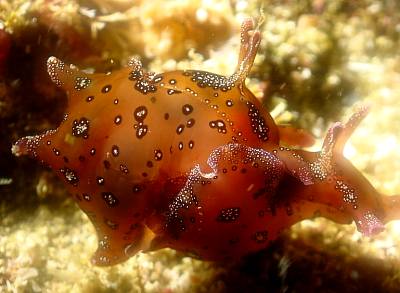
Dear Bill,
Here are some more photos of the species you previously identified as Aplysia parvula.
In the first photo there are 2 specimens mating, so it proves to me that these small sea-hares are adult. In the other photos there is a specimen with different colour tinge. It gives us a good idea of local colour range.
Upper Photo: Dakar, Senegal, Eastern Atlantic. Site: Banc du Seminole., Depth: 26m. May 27, 2003. Size: 30mm
Lower Photos: Dakar, Senegal, Eastern Atlantic. Site: Tacoma Wreck, Depth: 11m., June 06, 2003. Size: 35mm. Photos: Marina Poddubetskaia - Nembro website
Best wishes,
Marina.
nembro@nembro.info
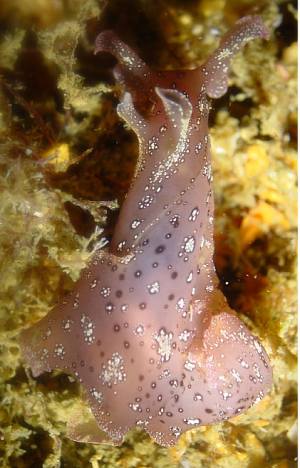

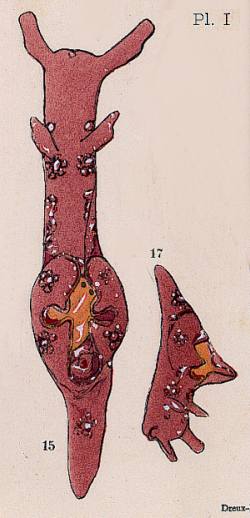
Thanks Marina,
Yes this is the species I have identified earlier as Aplysia parvula. Unfortunately I an't see the mantle foramen in any of your photos. If you have a photo showing this it would be useful. As you can see in Dong Bum Koh's photo from Korea, in A. parvula the foramen is very large.
I meant to mention before that Pruvot-Fol (1953) illustrated this colour form from Senegal and proposed a new species name Aplysia vistosa [37-8, Plate 1, figs 15, 17] for it. So if it does prove distinct from A. parvula there is a name waiting for it.
PHOTO: Aplysia vistosa - Plate 1, figs 15, 17, Pruvot-Fol, 1953.
• Pruvot-Fol, A. (1953) Etude de quelques opisthobranches de la cote Atlantique du Maroc et du Senegal. Travaux de l'Institute Scientifique Cherifien, Zoologie, 5: 1-105. (Pls. 1-3)
Best wishes,
Bill Rudman
Aplysia parvula from Senegal
April 29, 2003
From: Marina & Patrice
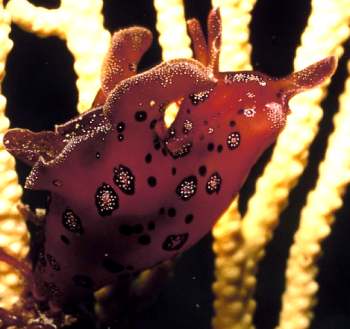
Dear Bill,
Here is another nice guy from Dakar, Senegal. We have some difficulties trying to identify it. Could it be Aplysia oculifera?
Patrice took this photo in April 1999.
Site: Grand Thiouriba
Depth: 29m
Temperature: 16°C
Best wishes,
Marina Poddubetskaia
nembro@nembro.info
Patrice Petit de Voize
PdeVoize@aol.com
Poddubetskaia, M. & Petit de Voize, P., 2003 (Apr 29) Aplysia parvula from Senegal. [Message in] Sea Slug Forum. Australian Museum, Sydney. Available from http://www.seaslugforum.net/find/9803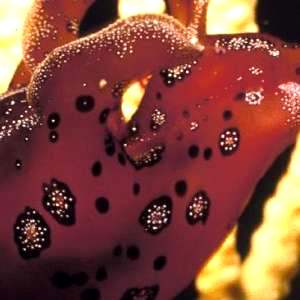
Dear Marina & Patrice,
This interesting photo made be do a bit more 'housework' on the Forum, tidying up a few loose ends concerning the Atlantic aplysiids. I am pretty sure this animal is an extreme colour form of Aplysia parvula. Have a look at Valda Fraser's photo of a South African colour form to see how the white spots aggregate into rings around a large white spot. Another clue are the development of what look like almost semipermanent lobes on the parapodial edge, which is also a feature of A. parvula. Perhaps this West African form will prove to be a distinctive species or subspecies, but a lot of work will need to be done worldwide before we can make such decisions.
I have used this occasion as an opportunity to move Erwin Koehler's Croatian animals from their position as a doubtful A. punctata, to the A. parvula page. Although they lack any black edging to the parapodia, their shape and the aggregations of white spots are very typical of A. parvula.
Best wishes,
Bill Rudman
Aplysia parvula from Outer Hebrides, Scotland
April 29, 2003
From: Bill Rudman
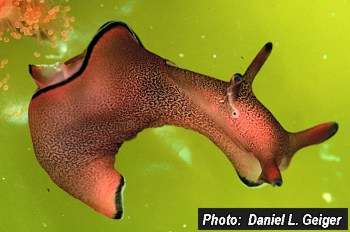
As part of a re-arrangement of some of the European aplysiids on the Forum I am moving this photo, previously labelled 'A. punctata? or A. parvula?' to the Aplysia parvula page. There is litle doubt that this species occurs ocasionally as far north as the United Kingdom.
St. Kilda, Outer Hebrides, Scotland, United Kingdom, 1993. PHOTOS: Daniel Geiger
Bill Rudman
Rudman, W.B., 2003 (Apr 29) Aplysia parvula from Outer Hebrides, Scotland. [Message in] Sea Slug Forum. Australian Museum, Sydney. Available from http://www.seaslugforum.net/find/9810Aplysia parvula from California
July 29, 2002
From: Bruce Wight
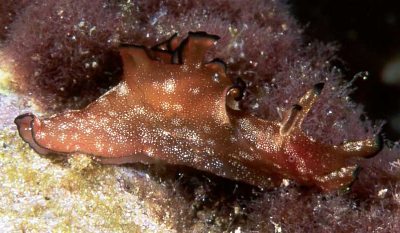

Hi Doc,
It appears from scanning over all the messages on your site that Aplysia parvula does indeed have world wide distribution. It differs from the two common Aplysia species found in California, A. vaccaria and A. californica for it has a very dark blue, almost black, line on the end of the parapodial flaps and is smaller in size. These images of A. parvula were photographed out at San Clemente Island, [California] and were around 1.5 inches in length.
Take care,
Bruce Wight
bwproductions@earthlink.net
Wight. B., 2002 (Jul 29) Aplysia parvula from California. [Message in] Sea Slug Forum. Australian Museum, Sydney. Available from http://www.seaslugforum.net/find/7626Thanks Bruce,
Bill Rudman
Mediterranean Aplysia parvula - dwarf male?
July 18, 2002
From: Marina Poddubetskaia
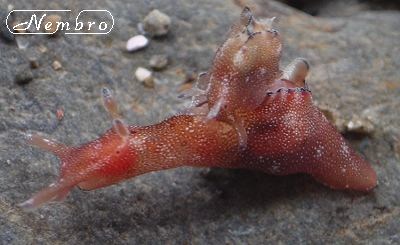
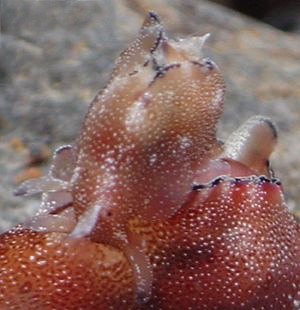
Dear Bill,
There is a photo of Aplysia parvula mating (+ a close-up of smaller animal). These animals was found on algae Sphaerococcus coronopifolius.
I brought them to a tank (to better see them and to let them go away later). So, I saw them mating for over an hour. The photo was taken in the tank.
Date : July 05, 2002
Location : Cerbere, France [Mediterranean coast]
Site : La Ramere
Depth : 10m
Size of the bigger animal : about 2cm
Best wishes,
Marina.
nembro@nembro.info
Poddubetskaia, M., 2002 (Jul 18) Mediterranean Aplysia parvula - dwarf male?. [Message in] Sea Slug Forum. Australian Museum, Sydney. Available from http://www.seaslugforum.net/find/7499Thanks Marina,
It's nice to get some photos of Mediterraean specimens of A. parvula, and some more examples of smaller animals mating with larger animals. I suspect, as in Volvatella vigourouxi, that this is a case of protandry, where the male reproductive system matures before the female system.
Best wishes,
Bill Rudman
More on Aplysia parvula color forms
July 16, 2002
From: Cory Pittman

Dear Bill,
The solid-black form of Aplysia parvula with blue highlights is rare on Maui (I've only recorded 5 out of 194 found in my algae washes as "dark form"). The attached photo is of an animal collected in a wash on October 25, 1997. It was taken at a depth of about 11 m in mixed Halimeda and rubble at Airport Beach, Maui. While holding it, I observed it copulating with a typical, brown-and-cream animal that was collected in the same wash. So, that would support lumping the color forms although, unfortunately, I didn't photograph them "in the act". I recorded three animals as held in the dish with lengths of 8mm, 9mm and 5mm but didn't note which length referred to the black one. However, I recall the copulating pair as similar in size so the length of the animal in the photo was probably 8 or 9mm.
By the way, one or the other laid eggs. The mass was about 4mm in diameter and composed of a tangled, golden-brown string about 1/3 mm in thickness. The eggs hatched after approximately 8 days.
There may also be some changes in color with growth. The small, mottled animals (less than 20mm) that I usually pick up in washes are typically brown-and-cream, often with faint blue highlights. In contrast, the large, mottled animals (40 to 60mm) that I often see while snorkeling are typically black-and-cream and generally lack blue highlights.
Best wishes,
Cory
Cory@cet.com
Pittman, C., 2002 (Jul 16) More on Aplysia parvula color forms. [Message in] Sea Slug Forum. Australian Museum, Sydney. Available from http://www.seaslugforum.net/find/7483Thanks Cory,
I am very interested in hearing about the mating episode between the two colour forms. Certainly suggests they're related.
Best wishes,
Bill Rudman
Aplysia parvula - color forms?
July 9, 2002
From: Scott Johnson
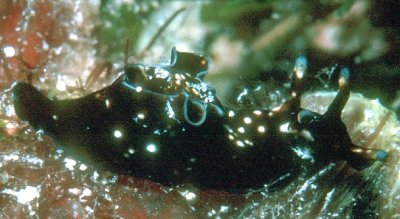
Hi Bill,
Here are what I've always assumed to be 3 color forms of Aplysia parvula from the Marshall Islands. Individuals out here typically run from 10 to 20mm in length and are found on shallow subtidal and intertidal reefs.
Scott Johnson
johnson@kmr.ll.mit.edu
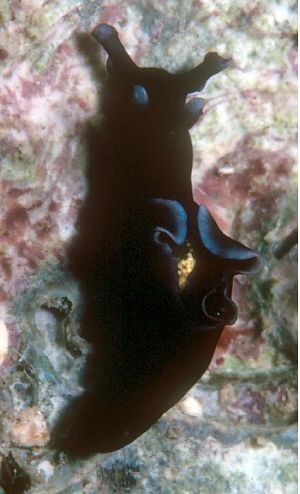
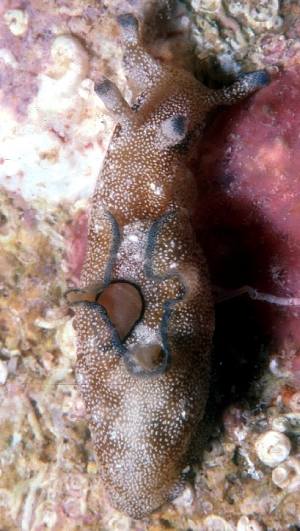
Thanks Scott,
I've also considered these to be forms of one species based on their size and shape. I have put the ones with the light coloured border on a separate page in the Forum, to draw attention to this colour difference. Considering the slight colour differences between some of the larger species of Aplysia, detailed studies may show these colour 'forms' of Aplysia parvula are distinct species, but if so, I suspect there is already a name or two already in the literature.
Best wishes,
Bill Rudman
Aplysia parvula from Korea
June 28, 2002
From: Dong Bum,Koh
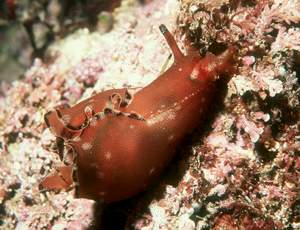
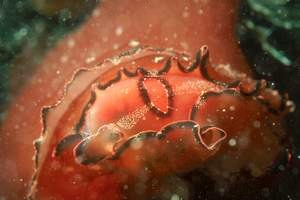
Dear Bill,
Here are two photos of what I think is Aplysia parvula taken on the north coast of Cheju island, Sth Korea.
When I looked closely at the posterior dorsum the animal released a yellowish material. I presume they are mating. Can you tell me about that?
Data: North coast of Cheju island about 6 years ago, 20m depth, Photo: Dong Bum, Koh.
Dong Bum,Koh
drkoh@seasee.co.kr
Koh, D.B., 2002 (Jun 28) Aplysia parvula from Korea. [Message in] Sea Slug Forum. Australian Museum, Sydney. Available from http://www.seaslugforum.net/find/7372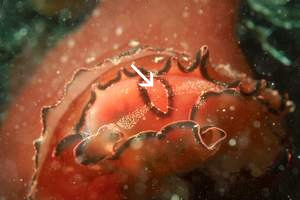
Dear Dong Bum,
This is Aplysia parvula. The black edge to the parapodia are very typical of this species. Another feature of this species is the wide opening on the mantle, also edged in black, through which the shell can be seen. I have marked this with an arrow in the photo alongside. In most species of Aplysia the opening [or foramen] through the mantle to the shell is microscopic and can only be seen as a small papilla. A. punctata is another species with a large foramen like this. In Stephen Hoskins' recent message about A. punctata you can see how the shell can pop out of the mantle, during preservation, when the foramen is so large.
Now to your question about the yellow secretion. I suspect that was either wastes from the kidney or the digestive system. In your lower photo there seem to be a small Aplysia sitting on the mantle of a larger animal. I can't see this clearly but otherwise I can't explain the outer parapodia. If this is so then yes the animals are almost certainly mating. I have seen this behaviour before in A. parvula and in the animal I am calling Aplysia cf. parvula. You will see in my photo of that animal, a smaller one sitting on the shell, between the parapodia, of a larger animal. It stayed there for at least 2 days with its penis inserted in the female aperture of the larger animal. The male organs of many opisthobranchs appear to mature before the female reprodcuctive organs. I suspect that this is the case in these species of Aplysia.
Best wishes,
Bill Rudman
Aplysia parvula from the Bahamas
June 8, 2002
From: Anne DuPont
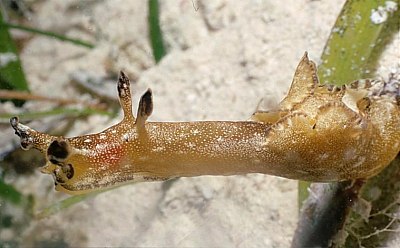
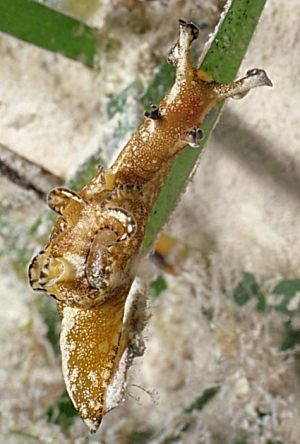
Hi Bill,
One day snorkeling in about 5 feet of water I found 4 tiny sea hares within about a foot of each other. They were about one-half inch to one and one-half inch long. They were in the same area that I found most of the A. dactylomela I mentioned in my earlier message. Is this a baby A. dactylomela or Aplysia parvula?
Photo taken Feb 3, 2002 in Southern Bahamas.
Thank you again for your time and the wonderful Forum.
Cordially,
Anne
akdupont@bellsouth.net
DuPont, A., 2002 (Jun 8) Aplysia parvula from the Bahamas. [Message in] Sea Slug Forum. Australian Museum, Sydney. Available from http://www.seaslugforum.net/find/7107Dear Anne,
This is Aplysia parvula. Thanks for these photos. It's very educational to see these photos from the Caribbean of species with a circum-global distribution.
Best wishes,
Bill Rudman
Re: Aplysia parvula from Bahia de Banderas
May 9, 2002
From: Alicia Hermosillo
Dear Dr. Rudman,
This Aplysia parvula was actually quite small, 5 mm. As it usually happens, after I saw my first (this one), I began finding more and more, living in different types of alga and with various colors going from red like this one to green. The biggest one I have found so far was 21 mm.
Ali
gueri25@hotmail.com
Thanks Ali,
Bill Rudman
Aplysia parvula from Bahia de Banderas
May 6, 2002
From: Alicia Hermosillo
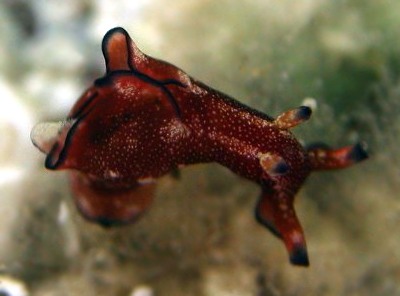
Dear Dr. Rudman,
I found this specimen of Aplysia parvula at Playa Mismaloya, Bahia de Banderas, Pacific Coast of Mexico. April 24th, 2002, at 30 feet of depth, living on the alga you can see in the picture.
Ali
gueri25@hotmail.com
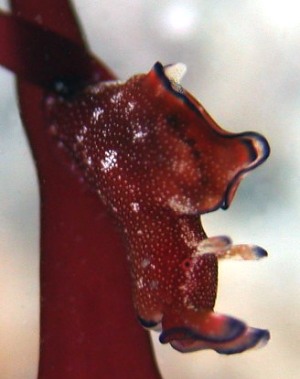
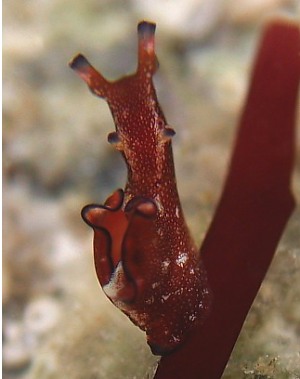
Thanks Ali,
It's certainly interesting to see photos of animals from the eastern Pacific. Can you give us an indication of its size please?
Best wishes,
Bill Rudman
Aplysia parvula from Sth Africa
August 9, 2001
From: Valda Fraser
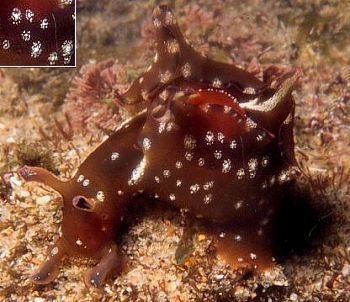
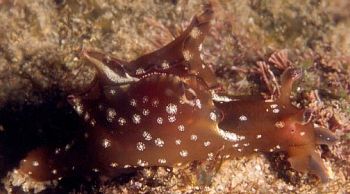
Dear Bill,
I have found a new kind of sea hare in my favourite intertidal pool. Who is this?
Locality: Pumula, south coast KwaZulu-Natal, SOUTH AFRICA
Date: July 2001
Size: 50mm
Thanks,
Valda Fraser
valdafraser@mweb.co.za
Fraser, V., 2001 (Aug 9) Aplysia parvula from Sth Africa. [Message in] Sea Slug Forum. Australian Museum, Sydney. Available from http://www.seaslugforum.net/find/4861Dear Valda,
Although it hasn't got the usual black edge to the parapodia I suspect this is Aplysia parvula.
Best wishes,
Bill Rudman.
Re: Juvenile Sea Hare
May 18, 2001
From: Juan Lucas Cervera
Dear Bill:
Your identification is correct. It's Aplysia parvula.
Regards.
Lucas.
lucas.cervera@uca.es
Cervera, J.L., 2001 (May 18) Re: Juvenile Sea Hare. [Message in] Sea Slug Forum. Australian Museum, Sydney. Available from http://www.seaslugforum.net/find/4352Thanks Lucas,
Bill
Juvenile Sea Hare
May 14, 2001
From: A. Fahrner & M. Schrödl

Hi Bill,
On our last collecting trip to Elba, Italy, we found an oxynoid specimen (2.5 mm) somewhat different from Oxynoe olivacea in color and in having broad and flat tentacles. Any idea what it is?
All the best from Munich,
Alexander Fahrner & Michael Schrödl
schroedl@zi.biologie.uni-muenchen.de
Fahrner, A. & Schrödl, M, 2001 (May 14) Juvenile Sea Hare. [Message in] Sea Slug Forum. Australian Museum, Sydney. Available from http://www.seaslugforum.net/find/4322Dear Alexander & Michael,
I am pretty sure this is a baby Sea Hare. At this small size their rhinophores are just beginning to appear as small bumps behind the eyes. If this was in the Indo-West Pacific I would also guess that this was Aplysia parvula both from its colour and from the brown prominent shell. This species also has a very large mantle foramen, usually bordered with black spots or a line. For those of you unfamiliar with the term 'foramen' it is a pore or larger hole in the mantle covering the shell. In some species it is an inconspicuous pore while in others, like A. parvula, it is often so large that the shell is only covered around the edge. I understand there have been reliable records of A. parvula from the Mediterranean.
Of course I could be quite wrong on any of these guesses so if anyone has another opinion please let us know.
Bill Rudman
Aplysia parvula from Sulawesi
August 5, 2000
From: Lindsay Warren
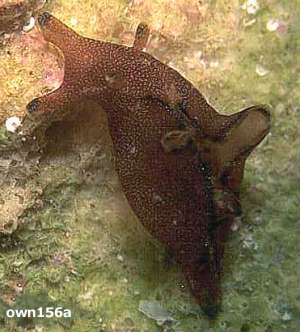
Dear Bill
The attached photos are of different specimens of what we believe to be the
same species of Aplysia.
OWN156a (OS0592) was found at 16:30 on 30 July 1999 by Guillermo Moreno on the mooring line of a rompong (fish attracting device in deep water) at a depth of 30 ft between the islands of Kaledupa and Hoga in the Tukang Besi Archipelago, SE Sulawesi, Indonesia (Operation Wallacea). L: 10 mm.
OWN156b (OS0811) was found at 10:30 on 25 September 1999 by Krzys Berkieta at a depth of 12 m on filamentous algae growing on plastic sheets which had been attached to lines beneath a rompong also moored between Kaledupa and Hoga in deep water (not the same one as above; there were 9 rompongs in
the area last year). L: 9 mm.
OWN156c (OS0790) was also found at 10:30 on 25 September 1999 by Krzys Berkieta between 10-12 m on a similar plastic 'frond'. There is a slight difference between this and the other specimens in that the upper area of the head and anterior notum is quite pale in comparison to the rest of the body. The rhinophores are also considerably paler. L: 7 mm.
Photos: Lindsay Warren.
They all feature brown bodies, speckled with cream / pale yellow spots. The margins of the undulating parapodia, tips of rolled rhinophores and oral tentacles are edged in charcoal / black. They all appear to have a thin shell beneath tissue between the parapodia. This tissue has several black spots on the right side and one hole just off centre towards the left. Oliver Miller found a 1.5 mm specimen (OWN172a / OS0638) - the smallest specimen found in the area to date - on 16 August at a depth of 11 m on filamentous algae on a mooring line on one of the sites on Pulau Hoga. Unfortunately the photo is not very clear so I have not bothered sending it to you.
I look forward to hearing what you think they might be.
All the best
Lindsay Warren
alldcl@compuserve.com
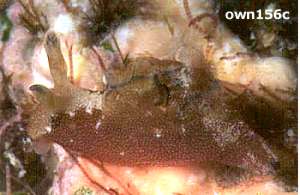
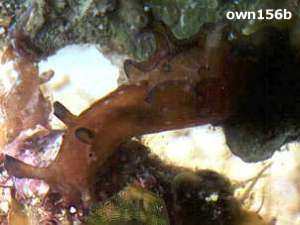
Dear Lindsay,
These are all forms of Aplysia parvula.
Bill Rudman.
Aplysia punctata or A. parvula?
October 18, 1999
From: Erwin Koehler

Bill,
attached is a photo of Aplysia punctata from the Mediterranean, Croatia, Moscenicka Draga, March 1998, size 5 cm, depth 3 m.
This one looks different from the ones by Daniel L. Geiger (who unfortunately did not record its size).
I own only two books with descriptions of A. punctata, both in German.
They tell the adults of A. punctata to be greenish-brown with rose and/or white spots, the juveniles are said to be dark red.
At the web I found photos from Scotland and Norway looking the same way as Daniel's (red with black ornaments). Is this really the same species?
The one with a black border at the parapodes and at the foot was posted at my site as Aplysia cf. parvula http://www.medslugs.de/E/North_Sea/Aplysia_cf_parvula_01.htm
Erwin
Medslugs.Koehler@t-online.de
Erwin Koehler, 1999 (Oct 18) Aplysia punctata or A. parvula?. [Message in] Sea Slug Forum. Australian Museum, Sydney. Available from http://www.seaslugforum.net/find/1435Note: moved to A. parvula. See discussion. 29 April 2003.
Dear Erwin,
It's a good question. There is a photo of a similarly coloured black-edged juvenile in Seashells of Western Europe by Bouchet, Danrigal & Huyghens, identified as Aplysia punctata. Aplysia parvula, often thought of as an Indo-West Pacific species, is considered by Eales (1960) to have a circum-global distribution. It has recently been reported a number of times from the Mediterranean and southern Britain. A. punctata and Aplysia parvula are the sole members of the subgenus Pruvotaplysia and so have many features in common. Externally, the main difference is said to be the black border in Aplysia parvula which is absent in A. punctata. Internally the main difference, according to Bebbington & Brown (1975), is that there are two penial retractor muscles in Aplysia parvula and one in A. punctata.
However Bebbington (1977) in a discussion of A. parvula, stated that he had re-examined Mediterranean specimens with the typical black markings of Aplysia parvula and found that they had the single penial retractor muscle characteristic of A. punctata! He concludes that 'these animals may be colour variants or may be hybrids and further investigation will have to be made'.
I can only agree with Bebbington's comment that further studies are required. It doesn't make for a tidy solution, but I guess that's what makes biology interesting. I think I will leave Daniel's photo where it is at present but make a note about the problems.
If anyone who has studied field populations of A. punctata can throw any light on the subject please do. Perhaps some juveniles have a black border which is lost as they grow?
Best wishes,
Bill Rudman.
•Bebbington, A. (1972) Aplysiid species from Malta with notes on the Mediterranean Aplysiomorpha (Gastropoda, Opisthobranchia). Pubblicazione Stazione Zoologica di Napoli 38 (for 1970): 25-46.
•Bebbington, A. (1975) On a collection of Aplysia species from Naples with a note on the distribution of Aplysia parvula (Gastropoda, Opisthobranchia) in the Mediterranean. Pubblicazioni Stazione Zoologica di Napoli 39: 121-128.
•Bebbington,A. & Brown,G.H. (1975) Aplysia parvula Guilding in Morch, an opisthobranch new to the British fauna. Journal of Conchology, 28: 329-333
•Bebbington, A. (1977): Aplysiid species from Eastern Australia with notes on the Pacific Ocean Aplysiomorpha (Gastropoda: Opisthobranchia). Transactions of the Zoological Society of London, 34: 87-147.
•Bouchet, P., Danrigal, F. & Huyghens, C. (1979) Sea Shells of Western Europe. American Malacologists: Melbourne, Florida. (translated by B. Picton).
